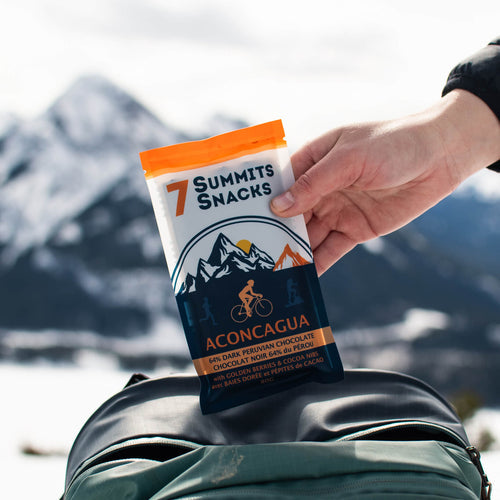
Golden berries: a fuel for exercise and the immune system
Share
We’re living in an era where even the word ‘unprecedented’, is being used an unprecedented number of times. Races have been cancelled and our adventures were postponed. But the world is re-opening, and I hear you ask: “How do I stay healthy and free from infection over the coming days, weeks and months?”.
Wearing facemasks and socially-distancing are the obvious answers. But did you know that exercise and fuelling our body with so-called ‘superfoods’ to reduce inflammation also strengthens our immune system.

A Brief History of The Golden Berry
One such superfood are golden berries (also known as Cape gooseberries, Peruvian groundcherries and, if that wasn’t enough, physalis peruviana). These tomato-like orange fruits come wrapped in a fragile husk.
They’re a produce native to South America, but their popularity since the 18th century – fuelled by a reputation for being a natural remedy for jaundice – has led to these delicious little fruits being cultivated in a host of climates, including South Africa, China, Australia and, incredibly, the rainy shores of England.
For such a powerfully tart and sweet fruit, Golden berries are a low calorie (77 kcal per 100 grams) delivery vehicle for micronutrients, such as vitamins, minerals and antioxidants(1). But, in a market that is full of companies advertising synthetic powders, capsules and drinks to improve the strength of our immune systems, especially with a certain virus doing the rounds, does a little orange fruit still hold value for your everyday diet?
The Nutritional Benefits of Golden Berries
Yes, because despite popular belief, natural sources of micronutrients increase the vitamin content of the blood to a similar extent to their synthetic counterparts2. So, the 11 milligrams of vitamin C in every 100 grams of golden berries are biologically available to increase the number of white blood cells (or, lymphocytes) that travel around your body to track down and fight a host of pathogens, including viruses.
If you have already picked up a bug that has caused inflammation and oxidative stress in your blood, muscles or airways – Golden berries also contain carotenoids and polyphenols that prevent the release of substances that cause inflammation (e.g. cytokines) and damage to surrounding tissues(3,4). Even in a world without infections, the micronutrients within Golden berries are important to fuel your endurance endeavours.
For example, antioxidants within Golden berries – including, but not limited to carotenoids, polyphenols, and vitamins C and D are scientifically-proven to improve exercise performance by improving blood flow, reducing muscle damage and preventing the dreaded Delayed Onset Muscle Soreness (or, DOMS)(5).

Final Thoughts on Golden Berries
So, as the world begins to re-open; remember that while exercise itself is also a potent stimulator of the immune system, attending sporting and endurance events is known to increase the risk of picking up upper respiratory tract infections. Think: more person-to-person contacts, changes in sleep patterns, long-haul flights and nutritional hiccups(6). Therefore, when you are dusting off your racing shoes, washing the tubing of your hydration pack and searching for your beloved charity racing bib – make sure you save some suitcase space for our delightful Golden berry infused dark chocolate, Aconcagua Everyday Superfood Chocolate and Endurance Bars.
Article written by: Adam Causer
Reference List
1. Bazalar Pereda MS, Nazareno MA, Viturro CI. Nutritional and Antioxidant Properties of Physalis peruviana L. Fruits from the Argentinean Northern Andean Region. Plant Foods Hum Nutr. 2019;74(1):68-75. doi:10.1007/s11130-018-0702-1
2. Carr A, Vissers M. Synthetic or Food-Derived Vitamin C—Are They Equally Bioavailable? Nutrients. 2013;5(11):4284-4304. doi:10.3390/nu5114284
3. Park HA, Lee J-W, Kwon O-K, et al. Physalis peruviana L. inhibits airway inflammation induced by cigarette smoke and lipopolysaccharide through inhibition of extracellular sig-nal-regulated kinase and induction of heme oxygenase-1. Int J Mol Med. 2017;40(5):1557-1565. doi:10.3892/ijmm.2017.3139
4. Park H, Kwon O, Ryu H, et al. Physalis peruviana L. inhibits ovalbumin‑induced airway inflammation by attenuating the activation of NF‑κB and inflammatory molecules. Int J Mol Med. February 2019. doi:10.3892/ijmm.2019.4110
5. Powers SK, Jackson MJ. Exercise-Induced Oxidative Stress: Cellular Mechanisms and Impact on Muscle Force Production. Physiol Rev. 2008;88(4):1243-1276. doi:10.1152/physrev.00031.2007.
6. Gleeson M. Immunological aspects of sports nutrition. Immunol Cell Biol. 2016;94(2):117-123. doi:10.1038/icb.2015.109
